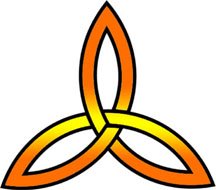One God in Three Divine Persons

Introduction
I remember sometime in 1980 a Protestant layman spoke to our students about drugs. He played the trumpet to get the attention of our students.
He took his lunch with us. After the meal, we said a thanksgiving prayer (We give you thanks…). What made a deep impression on us was that he made the sign of the cross (Protestants don’t make the sign of the cross) and he did it devoutly (while we did it hurriedly).
When we make the sign of the cross, we profess our faith in the Holy Trinity and we also identify ourselves as Catholics.
The Trinity
Belief in the Trinity means that we believe that there is one God in Three Divine Persons. We believe that the Father is God. We believe that Jesus is God. We be-lieve that the Holy Spirit is God. But there is only one God and not three gods.
Belief in the Trinity means that we believe that the Three Divine Persons are different from one another and equal to each other.
The Three Divine Persons are different from one another means that the Father is not the Son and is not the Holy Spirit; that the Son is not the Father and is not the Holy Spirit; and that the Holy Spirit is not the Father and is not the Son.
The Three Divine Persons are equal to each other mean that no one is greater than the other; that no one is “more God” than the other.
The Mystery
The Holy Trinity is a mystery of faith. Mystery of faith means that we believe in it only because it was revealed by Jesus to us. We read in the Gospel of Matthew: “Then Jesus approached and said to them, ‘All power in heaven and on earth has been given to me. Go, therefore, and make disciples of all nations, baptizing them in the name of the Father, and of the Son, and of the holy Spirit” (Mt 28:18-19).
Mystery of faith means that no matter how much we try we can not understand nor explain it completely.
What we often do is to use an analogy in order to shed some light on the mys-tery. For example, St. Patrick used the leaf of the shamrock to explain the Trinity. You may use the maple leaf of the Canadian flag. Or if you play cards, you can use the clover. Someone used the electric fan to explain the Trinity. There are three blades but when it is running you only see one blade.
The Dogma
The Holy Trinity is a dogma of faith. Dogma means that it has been officially proclaimed as something which is true and therefore, you have to believe if you are to be called a Christian.
The Holy Trinity as a dogma of faith does not mean that Christians did not be-lieve in the Holy Trinity before the official proclamation.
Then why do you have to make an official proclamation? It was because at some point, some people began teaching things which contradicted the belief in the Holy Trinity. The result was confusion (Ano nga ba talaga?). And so the Church had to step in and make an official proclamation.
Conclusion
If you go to the Church of St. Cecilia in Rome, go the main altar. There you will find a marble statue of St. Cecilia made by a Carlo Maderna. St. Cecilia is depicted as lying prostrate with a wound in her neck. The executioner did not succeed in completely cutting off her head. But look at her hands. Her right hand has the fore-finger extended while the left hand has the forefinger, the middle finger and the ring finger extended. What does that mean? At her death she was proclaiming her faith in the one God in Three Divine Persons. She was proclaiming her faith in the Trinity.
No comments:
Post a Comment